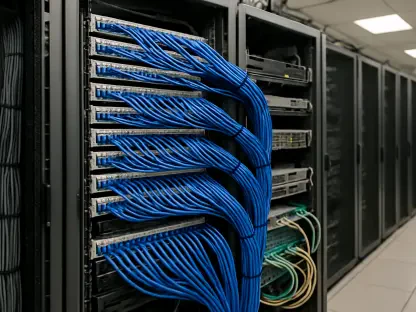Cisco, a global leader renowned for its innovative solutions, has unveiled a groundbreaking network architecture designed to transform workplaces powered by Artificial Intelligence (AI). This development is a strategic move aimed at addressing the challenges presented by the AI era, which include managing rapidly increasing network traffic, ensuring critical uptime, and countering sophisticated security threats. By integrating advanced AI-powered tools and devices, Cisco seeks to offer a streamlined approach to operational complexity while delivering high performance and robust security within network infrastructures. As enterprises across industries embrace AI technologies, the complexity of their network operations has surged due to the growing data traffic and novel security challenges. Recognizing the need to update these networks to support successful AI and Internet of Things (IoT) initiatives, Cisco stands at the forefront. Its new architecture promises to mitigate the substantial costs associated with network outages and bolster enterprise confidence in adopting AI solutions without compromising efficiency or security.
AI Integration and Network Enhancement
Central to Cisco’s latest network architecture is the seamless integration of AI-driven management capabilities, cutting-edge, high-capacity devices, and a forward-thinking quantum-resistant security framework. These features enable both IT and Operational Technology (OT) operations to be simplified, effectively enhancing workforce productivity and allowing businesses to scale AI solutions confidently. With the ever-growing data traffic and emerging security threats that AI brings to modern workspaces, Cisco’s architecture serves as a crucial tool for enterprises navigating the intricate landscape of AI technology. The company emphasized its commitment at the Cisco Live event, focusing on supporting organizations to navigate AI-induced shifts in network traffic and uptime requirements. Among IT networking leaders surveyed, almost all acknowledged the necessity for network upgrades to support AI initiatives. With its secure network architecture, Cisco has set new operational management and security benchmarks, allowing enterprises to transition towards AI integration without sacrificing performance or safety.
The unified management platform of this new architecture exemplifies Cisco’s commitment to facilitating an easier operational environment. By consolidating control over Meraki and Catalyst devices, this platform supports next-generation wireless, switching, and routing operations and extends its reach to industrial networks. It offers deployment flexibility across cloud, on-prem, or hybrid environments and includes insights from ThousandEyes, which now supports mobile endpoints and industrial IoT. This grants enterprises unparalleled visibility and control over their networks. Innovative features include real-time insights through a ThousandEyes and Splunk integration, providing businesses with comprehensive assurance and observability across their infrastructure.
Innovative Operational Management
To elevate management operations further, Cisco has introduced AgenticOps—an AI-powered operational model that transforms real-time telemetry and domain expertise into intelligent actions. This approach uses machine-speed interventions alongside human oversight to resolve operational challenges more efficiently. The introduction of the Cisco AI Assistant is notable; it uses a natural language interface to diagnose issues, automatically pinpointing root causes and automating workflows, drastically reducing task completion time. A standout feature, AI Canvas, emerges as an innovative generative AI user interface that encourages collaboration among NetOps, SecOps, and DevOps teams. This interface harmonizes operations, reducing IT burden and optimizing efficiency across teams.
Alongside these operational enhancements, Cisco announced the release of next-generation network devices designed for AI workloads, focusing on delivering low latency, high capacity, and robust security tailored to specific challenges. These products include new Cisco Smart Switches, capable of delivering high throughput, minimal latency, and secure networking through quantum-resistant models. The introduction of new Cisco Secure Routers integrates SD-WAN, SASE, a next-gen firewall, and post-quantum security, offering triple the throughput compared to earlier models. These devices underscore Cisco’s focus on optimizing network environments to meet the demands of modern AI applications.
Security Prioritization and Future Implications
Security is pivotal in Cisco’s new network architecture, particularly in responding to evolving cybersecurity challenges. Integrating advanced security measures across three critical network layers—infrastructure security, data transit security, and user, endpoint, and application protection—ensures a robust posture. Kernel-level controls, enhanced data encryption featuring post-quantum-ready technologies, and intelligence from Cisco’s Identity Services Engine and Talos fortify networks against emerging threats. Analyst perspectives echo the significance of Cisco’s strides in addressing AI-driven demands, emphasizing the architecture’s future-ready design as a proactive measure for enterprises adopting AI technologies.
This network architecture, currently available through Cisco and certified partners, offers deployment flexibility across cloud, hybrid, or on-prem environments. The unified management platform is operational, while the Cisco AI Assistant is in public beta. Testing for the Cisco AI Canvas is underway with select customers. Cisco’s architectural advances narrate significant technological progress, helping enterprises move toward AI-enabled operations, underlining a synthesis of operational efficiency, security, and performance. As AI continues to reshape the nature of workplace environments, Cisco exemplifies its ability to drive forward-thinking strategies, ensuring a holistic approach to network management and security.
Navigating a Future-Ready Network Ecosystem
Cisco, a global leader known for its cutting-edge solutions, has introduced a revolutionary network architecture aimed at transforming workplaces enhanced by Artificial Intelligence (AI). This initiative is targeted at overcoming the challenges of the AI era, which include managing soaring network traffic, ensuring essential uptime, and combating advanced security threats. Through the integration of sophisticated AI-enhanced tools and devices, Cisco seeks to simplify operational complexity while providing high performance and robust security within network infrastructures. As companies across various sectors increasingly integrate AI technologies, their network operations have become more complex due to the surge in data traffic and emerging security threats. Recognizing the necessity to upgrade these networks to support successful AI and IoT implementations, Cisco is at the forefront. Its new architecture aims to reduce the significant costs associated with network failures and enhance enterprise confidence in adopting AI solutions without compromising on efficiency or security.









